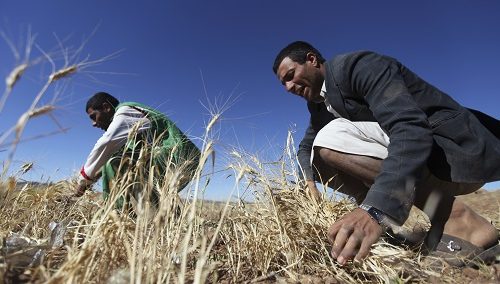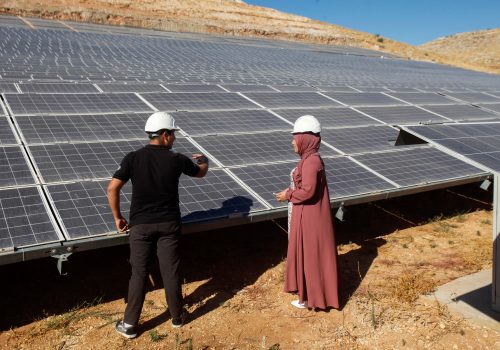Climate vulnerability and food insecurity in MENA should be priorities for US policymakers
Global challenges that have been compounded this year have left the world community adrift from where its efforts need to be, with particularly dire implications for the water-scarce and conflict-torn Middle East and North Africa (MENA). This should be a sobering moment for governments in the region and others with important partnerships with MENA.
The wounds of civil war in several MENA countries are still open and have been since 2011, when the 2008-2009 and 2010-2011 food price crises that aggravated pre-existing economic and political grievances sparked unrest in Tunisia, Egypt, and beyond. Additionally, an extra-regional war is raging, with potent transregional shockwaves reverberating in MENA. This war risks further derailing the international community’s efforts to address the climate crisis, creating intolerable conditions for millions in MENA.
Russia’s invasion of Ukraine in late February has come on the heels of two dreadful years in which the COVID-19 pandemic has wreaked havoc across economies globally. From financial losses and rising unemployment, to disrupted supply chains for everything from food to microchips, the pandemic and its fallout have left producers and consumers struggling. Russia’s war is adding fuel to the flames in MENA.
Food insecurity and climate change
The last thing the region needed was another economic shock to global food supply chains. MENA depends heavily on supplies from Russia and Ukraine, which account for 27 percent and 53 percent of the global trade in wheat—a staple food in MENA—and sunflower oil and seeds, respectively. Ukraine and Russia are the sources of over 50 percent of wheat imports in at least five MENA countries: Egypt, Sudan, Libya, Tunisia, and Yemen. This percentage rises to 75 percent and over 80 percent in Sudan and Egypt, respectively. Syria relies mostly on Russia for its wheat imports, while Jordan imports most of its wheat from Romania and less than 10 percent from Ukraine.
The protraction of the war could exacerbate food price inflation in MENA markets, deepen poverty, and raise the risks of social unrest. Well before even the pandemic took a toll on the global economy, poverty was already significant in several MENA countries.
Current and consistent poverty data for MENA are some of the most difficult to come by. The most recently published data indicate that the poverty headcount ratio was 15.7 percent in Jordan (2018), 32.5 percent in Egypt (2017), and 15.2 percent in Tunisia (2015), based on national poverty lines. In Sudan and Yemen, the headcount ratio was 44 percent in Sudan and 48.6 percent in Yemen in 2014 (based on the World Bank’s mid-tier international poverty line: $3.2 a day). The situation in Yemen cannot be described simply in poverty or food insecurity terms: the country has the worst humanitarian crisis in the world, with at least two-thirds of its population affected. Meanwhile, Syria, whose government doesn’t report poverty data, has been experiencing a humanitarian emergency since 2011.
The report of the first working group of the Intergovernmental Panel on Climate Change (IPCC WGI) released in April is an alarm bell to the international community, particularly for MENA—the most arid region on Earth—to reorder its priorities. Global emissions of greenhouse gases and warming have continued during 2010-2019, and will persist throughout this century. If the world maintains its present trajectory, its outcomes will make MENA increasingly unlivable for its people. The hydrological impacts for this water-scarce region are disastrous: increasing aridity in North Africa and deepening droughts in West Asia. Most of the region’s surface extends throughout the Great African Sahara and the Sahara Desert of the Arabian Peninsula. Even within its transboundary river basins, MENA has some of the world’s driest countries, including Tunisia, Algeria, Egypt, and Jordan. Other physical impacts of global warming on MENA, which include extended, unprecedented heat waves and sea level rise that lay waste to fertile lands, are deeply worrisome for agriculture—a pillar of food security in countries such as Egypt, Sudan, Morocco, and Iraq.
The impact of the Ukraine war
Food security conditions in MENA could become perilously worse as the Russian war increases stress and shortages in the global food supply chains that the region heavily depends on.
During the United Nations (UN) Security Council’s March 23 session to address the humanitarian crisis in Ukraine, UN Chief António Guterres warned world leaders of the diversion of attention and funds away from humanitarian hot spots in MENA, with millions of people affected, particularly in Yemen and Syria. In April, he also took aim at the inadequacy of global climate actions and pledges, and compared the result to “sleep walking” due to the present trajectory of emissions and its implications for the Earth.
In 2021, US President Joe Biden renewed the United States’ commitment to the 2015 Paris Agreement. The decision rekindled hope that the United States will again collaborate with the international community to galvanize efforts that address the climate crisis. At this stage of the crisis, the commitment of not just the United States but all leading industrial countries to robust climate action coupled with appropriate, timely support to fragile MENA countries cannot be overstated. One of the most urgent actions needed now is short-term and mid-term assistance measures to stabilize marginalized urban and agricultural communities in Jordan, Morocco, Tunisia, and Egypt. They are the only intact middle-income countries in the region at present. Their stability is like a stake hemming down the region amidst the building storm of food price inflation and associated economic grievances. It is important that these countries remain this way.
Freshwater scarcity, food import dependency, and vulnerability to international food trade shocks have shrunk the margins for coping with a systemic food crisis in MENA. Industrial countries must invest attention and resources to alleviate the compounded stressors that MENA populations are coming under in order to avert renewed instability that would be much costlier. A new wave of unrest in MENA would be intolerable for the world.
Amal A. Kandeel is a senior associate fellow at the King Faisal Center for Research and Islamic Studies. She is also an independent adviser for International Public Policy for Sustainable Development and the former founding director of the Climate Change and Human Security Program at the Middle East Institute.
Further reading
Fri, Aug 30, 2019
Climate-resilient small farming communities vital to MENA food security
MENASource By
Small farmers play a major role in the Middle East and North Africa (MENA) region’s food security. They produce the bulk of the region’s domestic supply of staples. However, small farm holders are among the most vulnerable to the impacts of climate change in the region.
Tue, Sep 29, 2020
Absence of PhD programs contributes to weak research and development in the Gulf
MENASource By
The production of new knowledge is a very complex process and many factors contribute to the low levels of innovation exhibited by the Gulf countries. One factor that plays a role is the structure of tertiary education—particularly PhD programs.
Thu, Aug 25, 2022
Brown-to-green subsidy swaps in MENA are long overdue. Here’s why.
MENASource By Amin Mohseni-Cheraghlou
Reforms in fossil fuel subsidies can help address many challenges and could result in many benefits for the MENA region.
Image: A worker sells subsidized food commodities at a government-run supermarket in Cairo, Egypt, February 14, 2016. Tens of millions of Egyptians rely on state subsidies provided as credits on smartcards they redeem against household staples each month. But in recent weeks, imported commodities like cooking oil have been in short supply as a dollar shortage makes it harder for state importers to secure regular supplies. Picture taken February 14, 2016. REUTERS/Mohamed Abd El Ghany


